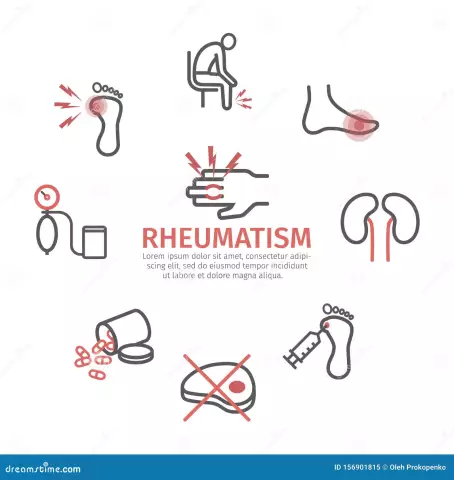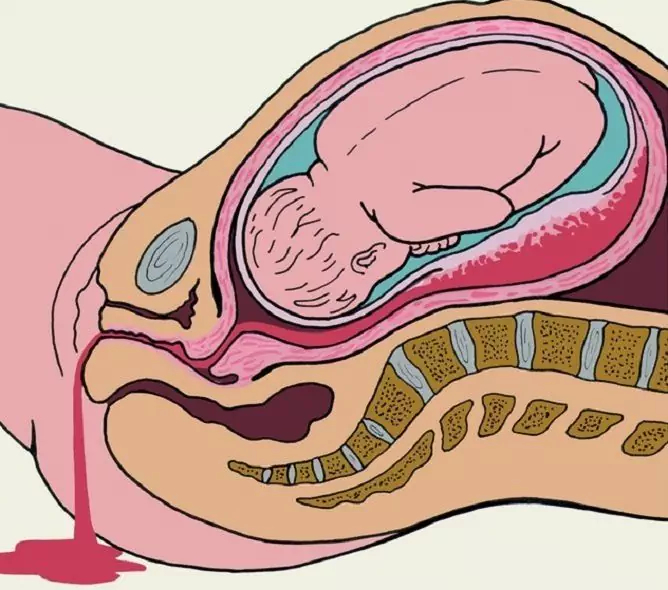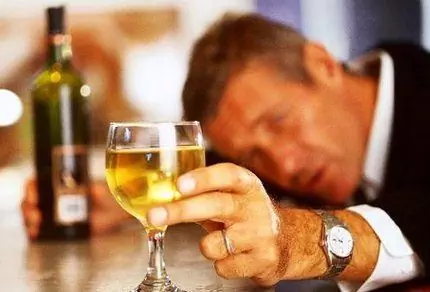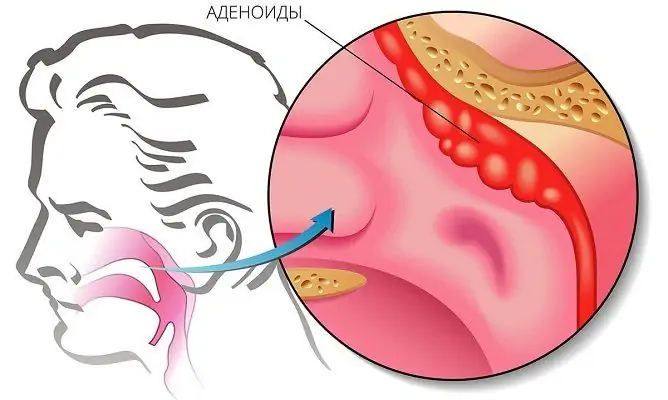- Author Rachel Wainwright [email protected].
- Public 2023-12-15 07:39.
- Last modified 2025-11-02 20:14.
Rheumatism

Rheumatism is an inflammatory systemic lesion of the connective tissue. Most often, this disease affects the musculoskeletal system, cardiovascular and nervous systems. Lesions of tendons, skin, kidneys, eyes, and digestive organs are rare. The course of the disease is not limited to one episode. The primary attack of this disease occurs in childhood and young age. The more attacks of the disease were, the more severe the consequences of rheumatism. The attack of rheumatism in children usually lasts at least two months.
Pathogenesis and causes of rheumatism
Epidemiological data, clinical observations, microbiological immunological and experimental studies indicate the connection of this disease with streptococcal infection. Under the influence of serological group A streptococci, the immune homeostasis of the human body is disrupted. When the balance between cellular and humoral immunity is disturbed, a group of lymphocytes is formed, which damages the connective tissue of various organs and systems of the body. Rheumatism can develop with regular hypothermia, malnutrition, overwork.
The hereditary predisposition to this disease is of great importance. In so-called rheumatic families, the incidence is three times higher than in the general population. The disease is inherited in a polygenic manner. Usually, in rheumatism, the connective tissue structures of the microvasculature are primarily affected, and later the process captures the connective tissue of the lungs, heart, joints, liver. Treatment of rheumatism, begun in the initial stage of connective tissue damage, can lead to a slowdown or cessation of the development of the pathological process.
Symptoms of rheumatism
There is an acute phase of rheumatism, subacute, protracted, continuously recurrent and latent (clinically asymptomatic).
Symptoms of rheumatism depend on the severity of proliferative, exudative phenomena, the degree of damage to the patient's organs and systems, as well as on the time of seeking medical help. The symptoms of the disease also depend on which organs the inflammation affects. Usually, the disease manifests itself some time after the recovery of sore throat caused by streptococcus. The main symptoms of rheumatism are arthritis (joint pain), fever, palpitations, and chest pain due to inflammation of the heart (carditis). With this disease, uncontrolled muscle twitching can be observed. An erythema ring (rash) may appear on the skin and small nodules under the skin. Lumps and rashes may be the only symptoms of rheumatism. The nodules are painless and disappear without treatment.
With rheumatism of the joints, sudden pain appears in one or several joints at once. The joints become red, swollen and hot. The knee, ankle, elbow joints, and wrists are most often affected. Sometimes the hip, shoulder joints, and small joints of the feet and hands are affected. Simultaneously with the appearance of pain in the joints, the body temperature begins to rise. Body temperature with rheumatism of the joints either decreases or rises again. The symptoms of rheumatism usually disappear within two weeks.
The rheumatic process can affect the myocardium, endocardium and pericardium. Rheumatism without marked cardiac changes is extremely rare. Inflammation of the outer shell of the heart can be accompanied by mild fatigue, shortness of breath, barking cough, vomiting, and nausea. The inflammation of the membrane sometimes leads to valve damage and rheumatic heart disease. Most often, the structure of the mitral valve is disrupted. Mitral valve injury is diagnosed by the characteristic heart murmur. With a narrowing of the opening of the mitral valve, mitral stenosis develops.
Uncontrolled twitching of the muscles with rheumatism also begins gradually. Twitching over time takes on the character of unfocused rapid chaotic movements. These movements disappear during sleep. Rheumatism in children is more severe and acute than in adults. Uncontrolled twitching can last four to eight months. That is why, with rheumatism in children, handwriting is severely deteriorated.
The course of the rheumatic process may be accompanied by vague clinical symptoms (weakness, decreased physical activity, the appearance of moderate shortness of breath after overload, low-grade or normal temperature, increased excitability, irritability and sleep disturbance).
Rheumatic lung disease usually presents with pleuropneumonia, pleurisy, and pneumonia.
Treatment of rheumatism

In the treatment of rheumatism, a three-stage system is used. In the active phase of the disease, inpatient treatment with bed rest is provided for a month. In the future, treatment is envisaged in a local cardio-rheumatological sanatorium. At the third stage, dispensary observation of the patient's condition is carried out in a polyclinic.
The complex for the treatment of rheumatism includes the use of physiotherapeutic procedures and medicines, as well as a balanced diet, including a dairy-plant diet with limited fluid and salt. Of the drugs for rheumatism, antibiotics (penicillin preparations), potassium preparations (asparkam, panangin), diuretics (lasix, furosemide), cardiac glycosides (isolanide, digitoxin, korglion, strophanthin-K) are indicated. The treatment must include ascorutin (rutin) and ascorbic acid.
Treatment of rheumatism with folk remedies
With rheumatism, herbal teas are very effective. To prepare the infusion, you need to take two parts of wild rosemary herb, two parts of a lingonberry leaf, two parts of a string, two parts of chamomile. Pour two tablespoons of the collection with half a liter of boiling water. Boil for ten minutes, then leave for 30 to 40 minutes, drain. Take a third of a glass three times a day after meals.
For rheumatism in the acute period, a phyto-collection will help, which includes four parts of silver birch leaves, two parts of black elderberry flowers, two parts of nettle leaves, one part of yarrow grass, three parts of meadowsweet, two parts of linden, two parts of horsetail. Brew one teaspoon of the collection with a glass of boiling water, insist. Drink instead of tea throughout the day. To avoid getting used to herbs, you can slightly change the composition of the herbal collection.
With rheumatism of the joints, a mixture prepared at home can be rubbed into the affected areas. To prepare it, you need to take one and a half glasses of radish juice, a glass of bee venom, half a glass of vodka, one tablespoon of salt.
For rheumatism of the joints, you can use bay leaf juniper ointment as an anesthetic and sedative for rubbing in. To prepare the ointment, you need to take six parts of a powdered bay leaf mixture and grind it with butter (12 parts).
YouTube video related to the article:
The information is generalized and provided for informational purposes only. At the first sign of illness, see your doctor. Self-medication is hazardous to health!






